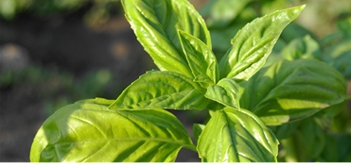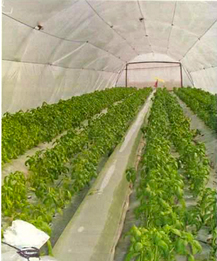Great Wall of China: Ginegar Solution for protecting crops
A new method for growing basil in tunnels heated by water sleeves opens up a chance to return the growers to the Beit She’an valley, so long as the heating costs prove reasonable.

In recent years, green spices have taken up a leading branch in agriculture in the Beit She’an valley. But growing basil in that area is a fairly expensive task, and the high heating costs have the growers, especially the major ones, looking towards warmer areas, specifically the region of the Dead Sea, where the weather conditions do not require over-large investments in heating during winter.
David Schapiro, mechanization and technology guide at The Agricultural Extension Office, tells us in a tour of Eden Farm in the Beit She’an valley, that the cost of heating one dunam of a hothouse in the area can reach as high as 30 thousand dollars during winter. “It was clear to us that if a lower cost heating solution is not found; all the growers will simply relocate to the Dead Sea area. In fact, the major growers have already done so. Those who are left, mostly smaller ones, are now rethinking their future, as the heating costs have lowered revenues to the very limit of feasibility. During winter, the farmers lose money, but they also continue growing crops in order to preserve the clients for the more profitable summer season. The clients allocate marketing shares based on the amount the suppliers can provide during the winter.”
The growers who have already moved to the Dead Sea area are glad for the development of the new technology which will lower the growing costs in the area, so that they can return home. Nobody wants to re-establish spice farms for enormous costs when the farms in their back yards already have well tended hothouses.
It turns out that quite a few farmers in the area cannot afford to wait until the official experiment results are published. They insert various components into their hothouses, which are implemented here at Eden Farms before the final results are published, because they just cannot bear the high heating costs.
A Chinese Hothouse
Eden Farm founded a project of basil growth tunnels to find the best, cheapest heating method. The method used so far is by fuel oil operated
heaters, which, as above mentioned, are very costly. The general idea is of the new method is to store the heat in the tunnels during the day, in order to release it in the cold hours of the night inside the growing tunnels. Experiments of this kind had already been performed here at the farm a few years back, and so there indeed was something to base the renewed project on. Schapiro explains: “We have joined together several technologies, each of which had already been introduced before, including storing heat in
wet soil, constructing a double side wall from plastic sheets and use of thermal sheets that trap the heat in the hothouse during the night, as well as the storage of heat in water sleeves”. Nine tunnels tall were constructed at the farm, each one 180 meters long. The basil was planted on the 26.11.2009. A different technology was tested in each tunnel. David notes that we have not had much of a winter this year yet, and the temperatures have not yet dropped as low as to endanger the basil, but the experiment was run anyway.
The model was taken from a well known Chinese method referred to as “A Chinese Hothouse”. In China, brick wall hothouses are built in cold areas to store heat during the day to radiate it back into the hothouse at night. Constructing such a hothouse is very expensive, and its operation entails many mechanical costs, because the hothouse must be covered with a blanket at night. But after all, our winters are not as harsh as the ones of China, and so we built improved Chinese hothouses, developed by David Schapiro, of whom we shall speak later.
During the first year of the experiment, the tunnels were built north to south, as is customary, so that the western and eastern sides of the tunnel receive an equal amount of light. But while this position allow for even lighting of the tunnels, it also creates a sharp angle for the sunrays reaching the structure, so that a large portion of the sunlight does not penetrate into the hothouse, and is reflected.
Positioning the hothouse east to west allows for direct and efficient impact and of sunlight. The imbalance created by the unevenness of the light is compensated for using added lighting fixtures. Attempts were made to add reflectors to the outer walls, but so far their contribution has not been proven to be significant.
The experiment includes several treatments and an inspection. In the first tunnel we entered we saw the soil covered with sheets of transparent plastic, allowing sunlight to penetrate the heat the soil.
“This year we did not add thermal screens to the experiment, due to their high costs and complex operation”, says David, “After all, the experiment is meant for farmers, and we must try and lower the costs to make the work as cheap and as simple as possible. Nevertheless, I am uncertain whether the removal of the screens was a good move”.
As part of the heat storing system, the tunnels are mostly kept sealed during the day, to improve heat storage for the night hours. The structures only open for a few hours at a time on the hottest of days, to release excess heat and facilitate water evaporation.
We now enter the test tunnel, in which no special treatment is held, and are plunged into heat and moisture. The temperature here around midday is approximately 35 degrees Celsius. At night it will drop to 9 degrees, with a temperature of about 6.5 degrees Celsius outside (results from last measurement). Needless to say, the each tunnel is equipped with means to measure the temperature of the air and soil. The basil looks very nice, and has already undergone first harvest. Appearances can be deceiving however, because, as we have already mentioned, the area has not yet seen cold this year, and so the plants were not hurt. David says that had the tunnel been damaged by cold, the results would have been visible on the plants, and that, in extreme cases the cold can even kill them.
We visited yet another tunnel, this one was laid lengthwise with water sleeves, each one 25 cm in diameter. The soil is covered with a transparent plastic sheet, and the hothouse has double walls. The temperature here can reach up to 48 degrees Celsius during the day, and drop to approx. 17 degrees at night, with only 7 degrees outside (results from last measurement). The basil in this hothouse looks nicer than in the test tunnel. David notes that basil begins to suffer from the cold when the temperature drops lower than ten degrees.
Another tunnel we entered also had a water sleeve installed for heating, but the difference was the deflector, installed to disperse the light more evenly. The next tunnel, also with a water sleeve, had not double walls.
The next hothouse contains an innovation: a wall of water! David explains that the idea of the water wall is taken from the upgraded Chinese hothouse, but instead of blocks, we used cylinders filled with water positioned vertically inside a metal grid. The water takes in the heat from the sun better than blocks. The back of the cylinders is painted black, followed by a reflector to improve heat intake. The hothouse is covered with a double walled plastic sheet, and the basil here is especially beautiful.
The length of the water wall is approx. 30 meters. It contains about 8 tons of water, accumulating heat energy during all hours of the day, and emitting it back into the tunnel at night.
Another tunnel we visit also has a water wall, but this time there are no double side walls.
In the tunnel that follows, the water cylinders are inserted into sleeves of black tin, which delivers better results, but is also more costly.
The Method’s Added Value
To summarize the tour, we sit in the office of Shahar Itzhak from Tel Teomim, director of research at the growth houses of Eden Farm. David lists the team members performing the work, among them, David Hadash, who is responsible for the growth aspect, Shahar Itzhak, the project manager, David Silverman, National spices training coordinator and Aryeh Itzhak, field service guide. The project would not have been launched had it not been for the significant push from Tzion Deko, director of R&D. David also wishes to mention the contribution of Dan Dagan, from the Agriculture Automation Company, which built the tunnels and water sleeves, and Yoram Shteigel from Ginegar Plastics. The experiment is funded by the head scientist.
“The experiment should solve a problem that has been bothering the farmers of the Jordan valley, Habashor region, and other regions of the country”, says David.
In answer to the question of whether those who moved their farms to the Dead Sea are will return after the experiment, David says that in his estimate they would, because those farmers have not yet established hothouses of their own, only rented existing hothouses in local settlements, so they could still come back.
It is important to note that the water sleeve heating method has an added value, for with this method the basil is grown disease free. This compared to fuel oil heating, for instance. The reason for this is that the water sleeve produces heat inside the hothouse, so that the temperature rises to over 40 degrees during the day, too hot for diseases to develop. Thus the need to invest work and money in pesticides is spared, not to mention the clients abroad who are happy to receive pesticide free produce. In fuel oil heated hothouses, crops must often be replaced in mid season due to diseases.
At this point, one cannot help but present David with the million dollar question: will they be able to offer the farmers a solar hothouse at reasonable cost at the end of the experiment?
To this he replies unambiguously: “Definitely yes!! The cost of the water wall is not too high, the tunnels in which the experiment takes place are fairly similar to the tunnels used in the experiment are fairly similar to those already in use at the farms, with the additional cost being only the addition of sheets to cover the soil, the water sleeves and the double side walls.”